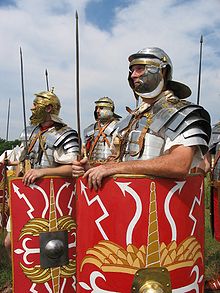- New Testament military metaphors
-
 New Testament military metaphors refer particularly to the legionaries of the 1st century Imperial Roman army.
New Testament military metaphors refer particularly to the legionaries of the 1st century Imperial Roman army.
The New Testament uses a number of military metaphors in discussing Christianity, especially in the Pauline epistles.
In Philippians 2:25[1] and Philemon 1:2,[2] Paul describes fellow Christians as "fellow soldiers" (in Greek, συστρατιώτῃ, sustratiōtē).[3] The image of a soldier is also used in 2 Timothy 2:3–4[4] as a metaphor for hard work and dedication,[5] similar to the metaphor of an athlete which follows. In 1 Corinthians 9:7,[6] this image is used in a discussion of church workers receiving payment, with a metaphorical reference to a soldier's rations and expenses.[7]
Ephesians 6:10–18[8] discusses faith, righteousness, and other elements of Christianity as the armour of God, and this imagery is replicated by John Bunyan in The Pilgrim's Progress,[9] and by many other Christian writers.
Related imagery appears in hymns such as Soldiers of Christ, Arise and Onward, Christian Soldiers.[10]
See also
- But to bring a sword
- Christians in the military
- Church militant and church triumphant
- New Testament athletic metaphors
- Salvation Army
- Spiritual warfare
- Military order
References
- ^ Philippians 2:25, NIV (BibleGateway).
- ^ Philemon 1:2, NIV (BibleGateway).
- ^ Peter Thomas O'Brien, The Epistle to the Philippians: A commentary on the Greek text, Eerdmans, 1991, ISBN 0853645310, pp. 330–331.
- ^ 2 Timothy 2:3–4, NIV (BibleGateway): "Endure hardship with us like a good soldier of Christ Jesus. No one serving as a soldier gets involved in civilian affairs—he wants to please his commanding officer."
- ^ John Norman Davidson Kelly, A Commentary on the Pastoral Epistles: I Timothy, II Timothy, Titus, Part 1, Continuum International Publishing Group, 1963, ISBN 0713613661, p. 175.
- ^ 1 Corinthians 9:7, NIV (BibleGateway): "Who serves as a soldier at his own expense?"
- ^ Anthony C. Thiselton, The First Epistle to the Corinthians: A commentary on the Greek text, Eerdmans, 2000, ISBN 0853645590, pp. 683-684.
- ^ Ephesians 6:10–18, NIV (BibleGateway).
- ^ Kathleen M. Swaim, Pilgrim's Progress, Puritan Progress: Discourses and Contexts, University of Illinois Press, 1993, ISBN 025201894X, p. 14.
- ^ Alison G. Sulloway, Gerard Manley Hopkins and the Victorian temper, Routledge, 1972, ISBN 0710073542, p. 220.
Categories:- New Testament
- Metaphors
- Metaphors referring to war and violence
- Christianity and violence
Wikimedia Foundation. 2010.
